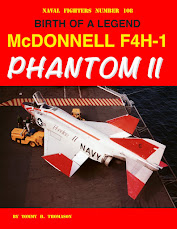The A-4F was originally powered by the Pratt&Whitney J52-P-8B engine rated at 9,300-lbs thrust. Many, reportedly 100 of the 147 built, were modified for the P-408 engine, with 11,200 lbs of thrust. For some reason the Navy didn't bother redesignating them as they usually did for a change of this type and magnitude. Informally, they were known as Super Foxes. The only external indication of the more powerful engine is the bigger inlet required for maximum low-speed thrust. When stripped of unnecessary weight and drag for use as a MiG surrogate in dissimilar air-to-air combat training, it was a formidable foe with its relatively high thrust-to-weight ratio, very high roll rate, and a small visual signature.
I had heard about the increase in the inlet size on the Super Fox, but for a long time assumed that it was an interior change because it is so subtle. From the side, it is very difficult to discern the exterior bulge because the depth of the inlet did not change, at least not on the outside. The Blue Angels' A-4s were Super Foxes, but I defy you to see the bigger inlet in this picture of No. 5 beginning the dirty roll to the left on takeoff:
The A-4Ms were also powered by the P-408 engine and had the bigger inlets but again, from the side, it's almost impossible to tell. (If you read on and then come back to this picture, you may be able to see a hint of it.)
However, when viewed from below or directly above, the outward bulge in the first three feet or so of the exterior is very apparent.
Compare the exterior of the inlet in the picture above to this top view drawing of the stock A-4F:
From the side, the bulge can also be seen in certain lighting.
In this case, you can see the crease of the start of the bulge. Its begins at the panel line that cuts through the aft end of the inlet warning triangle. The change in contour, which is normally very hard to discern, then angles up and forward on the inlet so that there is no bulge at the top. A similar crease is probably present on the lower half of exterior of the inlet but isn't evident here.
by Tommy H. Thomason
Subscribe to:
Post Comments (Atom)







I never noticed this before. Thanks for the info.
ReplyDelete